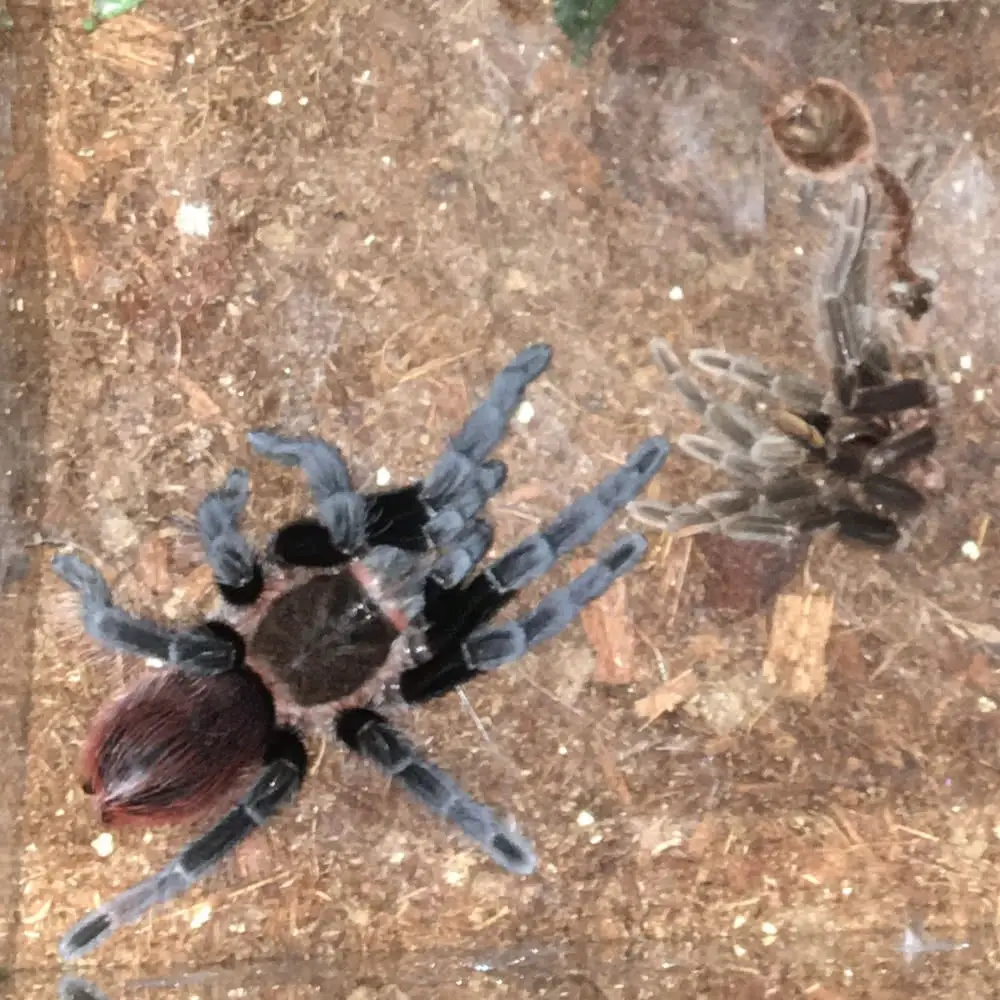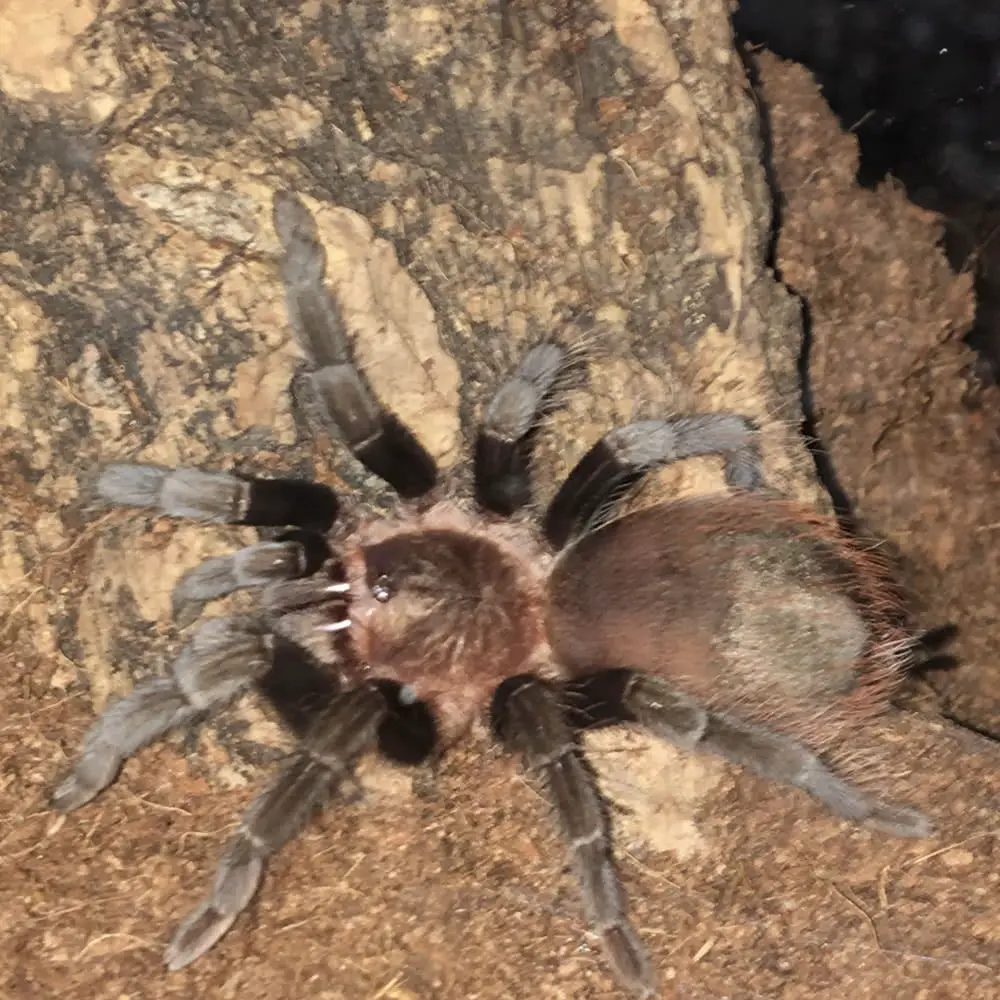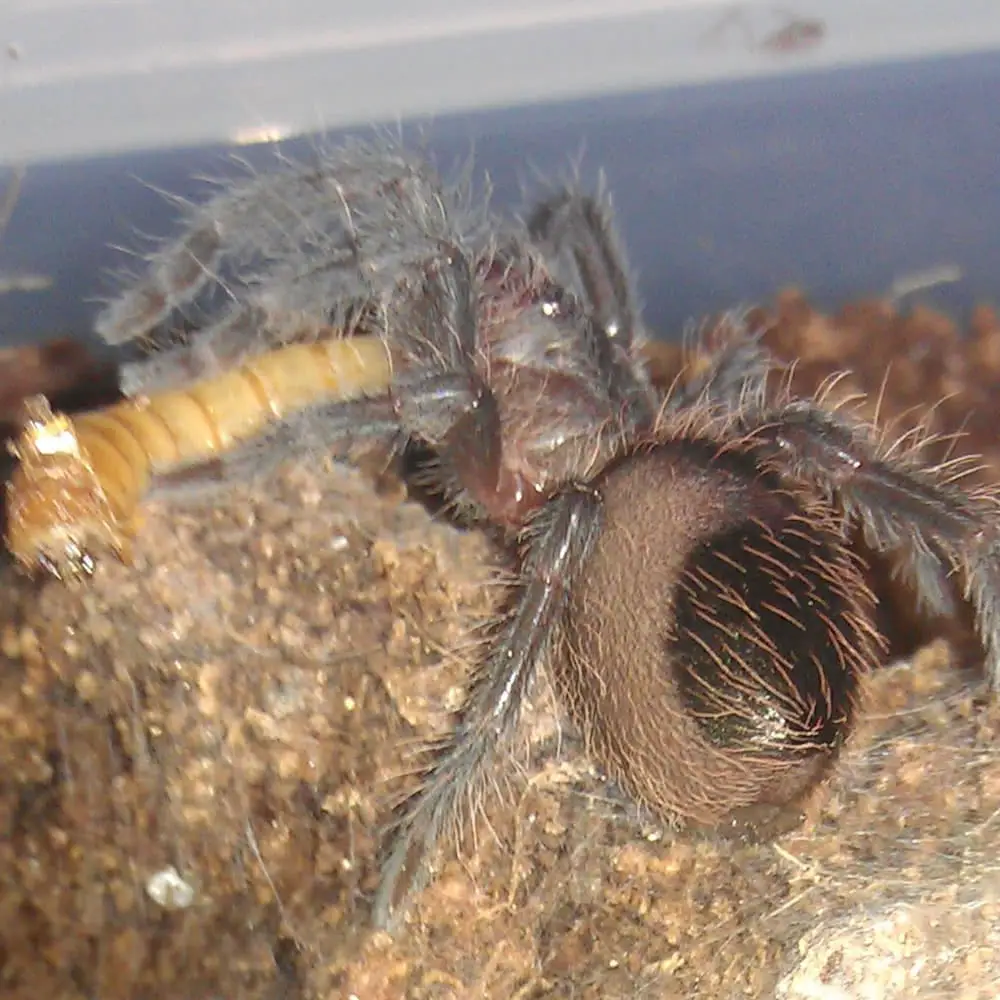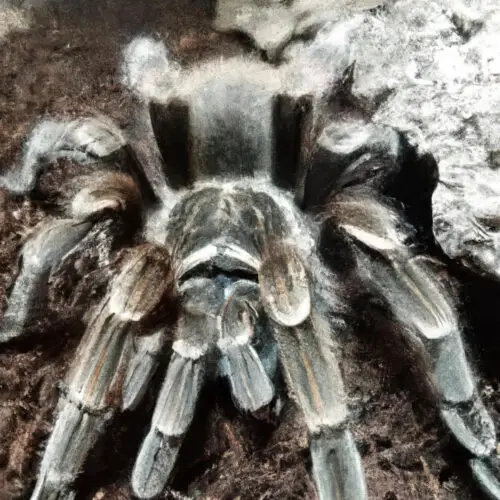The Mexican Red Rump Tarantula, also known as Brachypelma vagans, is a species of tarantula native to Mexico and other countries in Central America. It is a popular choice for tarantula enthusiasts due to its striking red hairs on the abdomen and docile nature. In this guide, we will explore the characteristics, temperament, natural habitat, care requirements, and other important aspects of keeping a Mexican Red Rump Tarantula as a pet.
Characteristics
The Mexican Red Rump Tarantula is a medium-sized tarantula, with adult females averaging around 5 to 6 inches in legspan, while males are generally smaller, with a legspan of around 4 to 5 inches. They have a dark-colored body with contrasting red hairs on the abdomen. Their bodies are covered with setae, which are bristle-like hairs that provide sensory feedback and help with thermoregulation.
Temperament & Behavior
The Mexican Red Rump Tarantula is generally known for its docile temperament and relatively calm behavior, making it a good choice for beginner tarantula keepers. They are not known to be aggressive and will usually resort to defensive behaviors such as flicking hairs as a first line of defense. However, as with any tarantula, they are individuals, and behavior can vary. Some may be more skittish or defensive than others.
Origin
The Mexican Red Rump Tarantula is native to Mexico, specifically the states of Guerrero, Morelos, and Oaxaca. It can also be found in other countries in Central America, including Honduras, Belize, and Guatemala.
Natural Habitat
In their natural habitat, Mexican Red Rump Tarantulas live in scrubland, grasslands, and tropical forests. They are predominantly terrestrial and create burrows in the ground or under rocks and logs. These burrows serve as both shelter and a hideout for ambushing prey.
Care
Housing
A properly sized enclosure is essential for the well-being of your Mexican Red Rump Tarantula. A 10-gallon terrarium or larger is recommended for adult specimens. The enclosure should provide enough space for the tarantula to move around and contain a suitable substrate, hiding places, and climbing opportunities.
Substrate
Use a substrate that mimics the tarantula’s natural habitat, such as a mixture of topsoil, peat moss, and coconut fiber. The substrate should be several inches deep to allow the tarantula to burrow if it desires. Ensure that the substrate is kept slightly moist, but not wet, as tarantulas prefer a humid environment.
Temperature & Humidity
The Mexican Red Rump Tarantula prefers temperatures ranging from 75 to 85 degrees Fahrenheit (24 to 29 degrees Celsius). Humidity levels should be kept around 70% to 80% to replicate their natural habitat. Use a hygrometer and thermometer to monitor and regulate the temperature and humidity inside the enclosure.
Lighting
Mexican Red Rump Tarantulas are nocturnal and do not require any special lighting. Ambient room lighting or low-level artificial lighting is sufficient.
Handling and Interaction
Although Mexican Red Rump Tarantulas are considered docile, handling should be kept to a minimum. Tarantulas are delicate creatures, and mishandling can result in injury or stress. It is best to observe them in their enclosure rather than handling them. If handling is necessary, it is important to be gentle and take precautionary measures to prevent accidental falls or escapes.
Health & Diseases
With proper care, the Mexican Red Rump Tarantula is generally hardy and resilient. However, they can be susceptible to some common tarantula ailments, such as molting issues, fungal infections, or parasites. Regularly check for signs of illness, such as a loss of appetite, lethargy, or unusual behavior. If you suspect any health issues, consult with a veterinarian experienced in exotic pets.
Diet & Feeding
Mexican Red Rump Tarantulas are carnivorous and primarily feed on insects and other small invertebrates. In captivity, their diet can consist of appropriately-sized prey items such as crickets, mealworms, roaches, and occasionally small mice for larger specimens. It is important to ensure that the prey items are gut-loaded and dusted with calcium powder to provide the necessary nutrients for the tarantula’s health.
Feeding frequency will depend on the size and age of the tarantula. Generally, juveniles should be fed small meals every 2 to 3 days, while adults can be fed every 7 to 10 days.
Breeding
Breeding Mexican Red Rump Tarantulas can be a rewarding experience for experienced tarantula keepers. It is important to have a mature male and female for successful reproduction. Courtship rituals can be complex and involve elaborate dances and drumming performed by the male to attract the female.
After successful mating, the female will lay eggs, which will be carried in an egg sac she attaches to her abdomen. The eggs will develop inside the sac until the spiderlings hatch. It is crucial to provide appropriate environmental conditions and humidity to ensure the successful development and hatching of the spiderlings.
Places You Find it on Sale
Mexican Red Rump Tarantulas are readily available in the pet trade. They can be found in specialized exotic pet stores, online reptile and arachnid forums, and reputable breeders or dealers. When purchasing a tarantula, always ensure that it comes from a reputable source and has been properly cared for.
Conclusions
The Mexican Red Rump Tarantula is a beautiful and relatively easy-to-care-for species of tarantula. With proper housing, diet, and care, they can live for many years in captivity. Always be prepared to provide a suitable habitat and meet their unique needs. As with any pet, it is crucial to research and understand their requirements before bringing one home. With the right knowledge and attention, the Mexican Red Rump Tarantula can make a fascinating and rewarding pet for arachnid enthusiasts.
Pictures




F.A.Q.
What is a Mexican Red Rump Tarantula?
The Mexican Red Rump Tarantula, also known as the Brachypelma vagans, is a species of tarantula native to Mexico and Central America.
How big do Mexican Red Rump Tarantulas get?
Adult Mexican Red Rump Tarantulas typically have a leg span ranging from 5 to 6 inches.
Are Mexican Red Rump Tarantulas venomous?
Yes, Mexican Red Rump Tarantulas have venom, although their bites are not considered medically significant to humans.
What do Mexican Red Rump Tarantulas eat?
They are carnivorous creatures and primarily eat insects, such as crickets, cockroaches, and mealworms.
How long do Mexican Red Rump Tarantulas live?
Mexican Red Rump Tarantulas have an average lifespan of approximately 10 to 15 years.
How often should I feed my Mexican Red Rump Tarantula?
Adult Mexican Red Rump Tarantulas can be fed 2 to 3 times per month, while juveniles may require more frequent feedings.
How often do Mexican Red Rump Tarantulas molt?
On average, Mexican Red Rump Tarantulas will molt their exoskeleton every 2 to 3 years.
What is the ideal temperature for keeping a Mexican Red Rump Tarantula?
The ideal temperature range for a Mexican Red Rump Tarantula is around 75 to 85 degrees Fahrenheit (24 to 29 degrees Celsius).
What type of substrate should I use in my Mexican Red Rump Tarantula’s enclosure?
A suitable substrate for a Mexican Red Rump Tarantula’s enclosure is a mixture of potting soil and coconut fiber.
Can Mexican Red Rump Tarantulas be handled?
While Mexican Red Rump Tarantulas are generally docile, it is not recommended to handle them as they can become stressed and may bite or flick urticating hairs at you.
What is the temperament of a Mexican Red Rump Tarantula?
Mexican Red Rump Tarantulas are typically calm and docile, but they can be defensive and flick urticating hairs if threatened.
What is the typical coloration of a Mexican Red Rump Tarantula?
As the name suggests, Mexican Red Rump Tarantulas have a black body with vibrant red hairs on their abdomen.
Can Mexican Red Rump Tarantulas tolerate humidity?
Yes, Mexican Red Rump Tarantulas naturally live in humid environments and require a humidity level of around 70% in their enclosure.
How should I provide water for my Mexican Red Rump Tarantula?
Provide a shallow water dish that is big enough for your tarantula to drink from but not deep enough to drown in.
Do Mexican Red Rump Tarantulas need UVB lighting?
No, Mexican Red Rump Tarantulas do not require UVB lighting, as they are primarily nocturnal and receive little to no direct sunlight in the wild.
What size enclosure does a Mexican Red Rump Tarantula need?
A 10-gallon terrarium is typically sufficient for an adult Mexican Red Rump Tarantula, but larger enclosures are always better.
Can I house multiple Mexican Red Rump Tarantulas together?
Mexican Red Rump Tarantulas are not communal species and should be housed separately to avoid potential aggression or cannibalism.
What should be included in a Mexican Red Rump Tarantula’s enclosure?
A suitable enclosure should include a hiding spot, water dish, appropriate substrate, and a secure lid to prevent escapes.
Do Mexican Red Rump Tarantulas require any special lighting?
No, Mexican Red Rump Tarantulas do not require any special lighting. A regular day and night schedule will suffice.
Can Mexican Red Rump Tarantulas climb glass or plastic walls?
Yes, Mexican Red Rump Tarantulas have the ability to climb glass or plastic walls, so a secure lid is essential to prevent escapes.
Are Mexican Red Rump Tarantulas easy to care for?
Yes, Mexican Red Rump Tarantulas are relatively easy to care for, making them a suitable tarantula species for beginners.
What should I do if my Mexican Red Rump Tarantula refuses to eat?
It is not uncommon for tarantulas to go through periods of fasting. If your Mexican Red Rump Tarantula refuses to eat for an extended period, monitor its weight and seek advice if it becomes a concern.
Should I provide a heat source for my Mexican Red Rump Tarantula?
Mexican Red Rump Tarantulas do not require additional heat sources, as they can tolerate room temperature quite well.
What is the best type of heating pad for a Mexican Red Rump Tarantula?
Heating pads are generally not necessary for Mexican Red Rump Tarantulas, as they do not require additional heat sources.
Can Mexican Red Rump Tarantulas be kept together with other pets?
While Mexican Red Rump Tarantulas are not a threat to most household pets, it is advisable to keep them separated to avoid any potential harm to either animal.
Can Mexican Red Rump Tarantulas be kept together with other tarantula species?
No, Mexican Red Rump Tarantulas are not communal and should be kept separately from other tarantula species to prevent aggression or cannibalism.
Can Mexican Red Rump Tarantulas swim?
No, Mexican Red Rump Tarantulas cannot swim and should not be placed in water deep enough to submerge them.
What should I do if my Mexican Red Rump Tarantula escapes?
If your Mexican Red Rump Tarantula escapes, remain calm and try to locate it by setting up traps or using a flashlight. If you are unable to find it, contact a local tarantula expert for advice.
What is the recommended humidity level for a Mexican Red Rump Tarantula?
The recommended humidity level for a Mexican Red Rump Tarantula is around 70%. This can be achieved by misting the enclosure with water or using a humidifier.
How often should I clean my Mexican Red Rump Tarantula’s enclosure?
Regular spot cleaning is important to remove any uneaten prey or waste. A complete enclosure cleaning should be done every few months to maintain a healthy environment.
What is the cost of a Mexican Red Rump Tarantula?
The cost of a Mexican Red Rump Tarantula can vary depending on factors such as size, sex, and availability, but generally ranges from $50 to $100.
Can Mexican Red Rump Tarantulas be kept in groups?
No, Mexican Red Rump Tarantulas are not communal spiders and should be kept individually to avoid potential aggression or cannibalism.
What are the common health issues for Mexican Red Rump Tarantulas?
Some common health issues for Mexican Red Rump Tarantulas include dehydration, mites, fungal infections, and injuries from falls or escapes.
Is it possible to handle a Mexican Red Rump Tarantula?
While Mexican Red Rump Tarantulas are generally docile, it is not recommended to handle them as they can become stressed and may bite or flick urticating hairs at you.
What should I do if my Mexican Red Rump Tarantula is not eating?
If your Mexican Red Rump Tarantula is not eating, monitor its weight and ensure all environmental conditions are ideal. If the issue persists, consult a veterinarian or tarantula expert for further advice.
What should I do if my Mexican Red Rump Tarantula gets injured?
If your Mexican Red Rump Tarantula gets injured, assess the severity of the injury. For minor injuries, ensure a clean and suitable environment for healing. In the case of more severe injuries, seek professional veterinary assistance.
Is it normal for my Mexican Red Rump Tarantula to be inactive all day?
Mexican Red Rump Tarantulas are primarily nocturnal creatures, so it is normal for them to be inactive during the day. If it remains inactive during its active period as well, it may indicate a health issue.
How long can Mexican Red Rump Tarantulas go without food?
Mexican Red Rump Tarantulas can go for several weeks or even months without food, especially during periods of fasting or molting.
What is the best way to handle a Mexican Red Rump Tarantula?
It is generally not recommended to handle Mexican Red Rump Tarantulas, as they can become stressed and may bite or flick urticating hairs at you. However, if necessary, the best method is to use a soft paintbrush or similar tool to gently guide it into a container or onto your hand.
Can I keep a Mexican Red Rump Tarantula in a plastic container?
A plastic container may not provide adequate ventilation for a Mexican Red Rump Tarantula, so it is recommended to use a well-ventilated glass or acrylic terrarium.
What should I do if my Mexican Red Rump Tarantula’s exoskeleton looks dull or discolored?
A dull or discolored exoskeleton can indicate that your Mexican Red Rump Tarantula is preparing to molt. Ensure the environment is well-humidified and avoid disturbing the tarantula during this time.
How often does a Mexican Red Rump Tarantula need to molt?
Mexican Red Rump Tarantulas typically molt every 2 to 3 years, although individual molting frequencies may vary.
Can Mexican Red Rump Tarantulas regrow lost limbs?
Mexican Red Rump Tarantulas have the ability to regenerate lost limbs during molting cycles.
Can Mexican Red Rump Tarantulas be kept in an artificial enclosure?
Yes, Mexican Red Rump Tarantulas can be kept in artificial enclosures, such as terrariums or vivariums, as long as the necessary environmental conditions are met.
What precautions should I take when handling a Mexican Red Rump Tarantula?
If handling a Mexican Red Rump Tarantula, always wash your hands thoroughly before and after to minimize the risk of infection. Additionally, wear protective gloves to reduce the chance of getting bitten or exposed to urticating hairs.
How can I tell if my Mexican Red Rump Tarantula is male or female?
Adult male Mexican Red Rump Tarantulas tend to have shorter lifespans and are generally smaller in size compared to females. Sexing can also be determined by examining the morphology of their pedipalps.
Is it normal for my Mexican Red Rump Tarantula to flick its urticating hairs?
Yes, Mexican Red Rump Tarantulas have specialized hairs called urticating hairs, which they can flick as a defense mechanism. This can be triggered when they feel threatened or agitated.
What is the best way to transport a Mexican Red Rump Tarantula?
When transporting a Mexican Red Rump Tarantula, it is best to use a secure, well-ventilated container and place it in a dark and quiet environment to minimize stress.
What can I do to provide environmental enrichment for my Mexican Red Rump Tarantula?
You can provide environmental enrichment for your Mexican Red Rump Tarantula by placing different types of hides, foliage, or other natural decorations in its enclosure to mimic its natural habitat.
How should I clean my Mexican Red Rump Tarantula’s water dish?
Cleaning the water dish of a Mexican Red Rump Tarantula can be done by removing it from the enclosure, discarding any debris, and washing it with warm water. Ensure it is thoroughly dried before refilling it.
Is it normal for my Mexican Red Rump Tarantula to dig burrows?
Yes, Mexican Red Rump Tarantulas are known to be burrowers and will often dig deep burrows to create a hiding spot and establish their territory.
Can Mexican Red Rump Tarantulas be kept in a bioactive enclosure?
Yes, Mexican Red Rump Tarantulas can be kept in a bioactive enclosure, where a natural ecosystem is established with live plants, microorganisms, and detritivores to help maintain the enclosure’s cleanliness.
What should I do if my Mexican Red Rump Tarantula is not drinking water?
Mexican Red Rump Tarantulas obtain most of their water from their prey, so it is not unusual for them to drink infrequently. However, you can mist the enclosure to provide moisture, and if you suspect dehydration, consult a tarantula expert for further advice.
Can Mexican Red Rump Tarantulas learn to recognize their owners?
Tarantulas, including Mexican Red Rump Tarantulas, do not have the ability to recognize individual humans like some mammals or birds.
Can Mexican Red Rump Tarantulas be kept in a bioactive enclosure with other small invertebrates?
It is generally not recommended to house Mexican Red Rump Tarantulas with other small invertebrates in a bioactive enclosure, as they may predate or disturb each other. It is safer to keep them separately.



